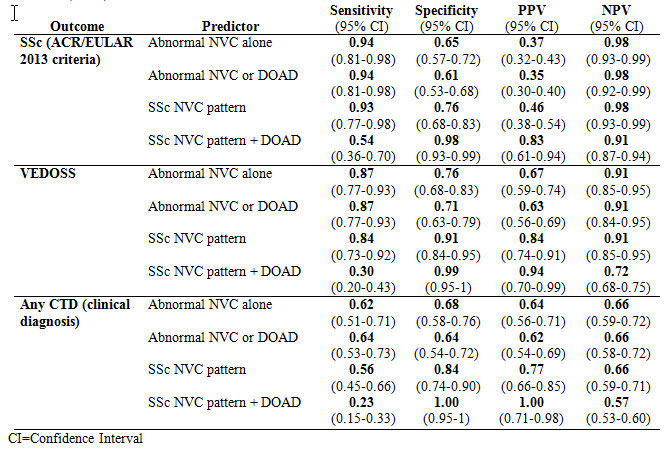Session Information
Session Type: Poster Session (Sunday)
Session Time: 9:00AM-11:00AM
Background/Purpose: Vasculopathy is a key feature of systemic sclerosis (SSc), a chronic autoimmune disease associated with widespread fibrosis and internal organ dysfunction. While structural abnormalities of the microcirculation are best seen on nailfold videocapillaroscopy (NVC), laser doppler flowmetry (LDF) with a thermal challenge is a highly accurate, safe, and noninvasive means to detect digital occlusive arterial disease (DOAD) with a sensitivity and specificity of >90% (1).We reviewed NVC patterns and DOAD on LDF in a cohort of patients referred to our NVC clinic for evaluation of Raynaud’s or suspected connective tissue disease (CTD), their correlation, and their predictive value in diagnosing SSc or any CTD.
Methods: Medical records of patients that underwent NVC and LDF at our institution between 1/1/2017 and 3/31/2019 were retrospectively reviewed. NVC results were classified as normal or abnormal (non-specific or SSc specific pattern- early, active or late). Presence or absence of DOAD on LDF was abstracted. Clinical diagnosis of CTDs and fulfilment of ACR/EULAR 2013 SSc classification criteria and Very early diagnosis of Systemic sclerosis (VEDOSS) criteria was ascertained.
Results: 190 patients (mean age 46 ± 15 yrs, 81% females, 93% white) underwent NVC and LDF during the study period. NVC was normal in 102 (54%) patients and abnormal in 88 (Non-specific 31[35%], SSc pattern 57[65%]).
On LDF with thermal challenge, 78% of patients had vasospasm and DOAD was noted in 30 (16%) patients. Among 30 patients with DOAD, a CTD was diagnosed in 24 (80%), of which 17 (57%) met SSc criteria.
Among the 30 patients with DOAD, 24 (80%) had abnormal NVC patterns with SSc NVC pattern in 18 (60%) (3 early, 8 active and 7 late). Among the 160 patients without DOAD, 93 (58%) did not have any CTD and NVC was normal in 96 (60%) of the patients.
SSc NVC pattern was strongly predictive of meeting VEDOSS (positive predictive value (PPV):84%) and diagnosis of CTDs (PPV: 77%). Addition of DOAD to SSc NVC pattern increased the likelihood of meeting SSc criteria (PPV increased from 46% to 83%), diagnosis of CTDs (PPV increased from 77% to 100%) and slightly improved fulfillment of VEDOSS.
Having normal NVC was associated with very low likelihood of SSc diagnosis (negative predictive value (NPV): 98%) and VEDOSS (NPV: 91%), but did not help significantly in exclusion of other CTDs (NPV: 66%). Using a composite predictor of abnormal NVC or DOAD did not significantly change the NPV for excluding SSc or CTDs, compared to NVC alone (Table ).
Conclusion: Our study suggests that the presence of DOAD on LDF in patients with RP and/or suspected CTD is strongly associated with presence of an underlying CTD, particularly SSc. Patients with DOAD and SSc, are more likely to have an ‘active or late’ SSc pattern on NVC rather than ‘early’. A SSc pattern NVC in combination with DOAD is very strongly predictive of an underlying CTD, with SSc in >80% cases. A normal NVC virtually excludes the presence of SSc, but not other CTDs. Adding LDF to NVC, can further increase the predictive value of NVC alone for CTD diagnosis.
Reference
(1) Mahe G et al. J Vasc Surg. 2014 Apr;59(4):1051-1057.e1
To cite this abstract in AMA style:
Radwan Y, Gunderson T, Crowson C, Liedl D, Hinze A, Warrington K, Wennberg P, Makol A. Nailfold Videocapillaroscopy Patterns and Digital Occlusive Arterial Disease on Laser Doppler Flowmetry Strongly Predicts the Diagnosis of Systemic Sclerosis and Other Connective Tissue Diseases [abstract]. Arthritis Rheumatol. 2019; 71 (suppl 10). https://acrabstracts.org/abstract/nailfold-videocapillaroscopy-patterns-and-digital-occlusive-arterial-disease-on-laser-doppler-flowmetry-strongly-predicts-the-diagnosis-of-systemic-sclerosis-and-other-connective-tissue-diseases/. Accessed .« Back to 2019 ACR/ARP Annual Meeting
ACR Meeting Abstracts - https://acrabstracts.org/abstract/nailfold-videocapillaroscopy-patterns-and-digital-occlusive-arterial-disease-on-laser-doppler-flowmetry-strongly-predicts-the-diagnosis-of-systemic-sclerosis-and-other-connective-tissue-diseases/

